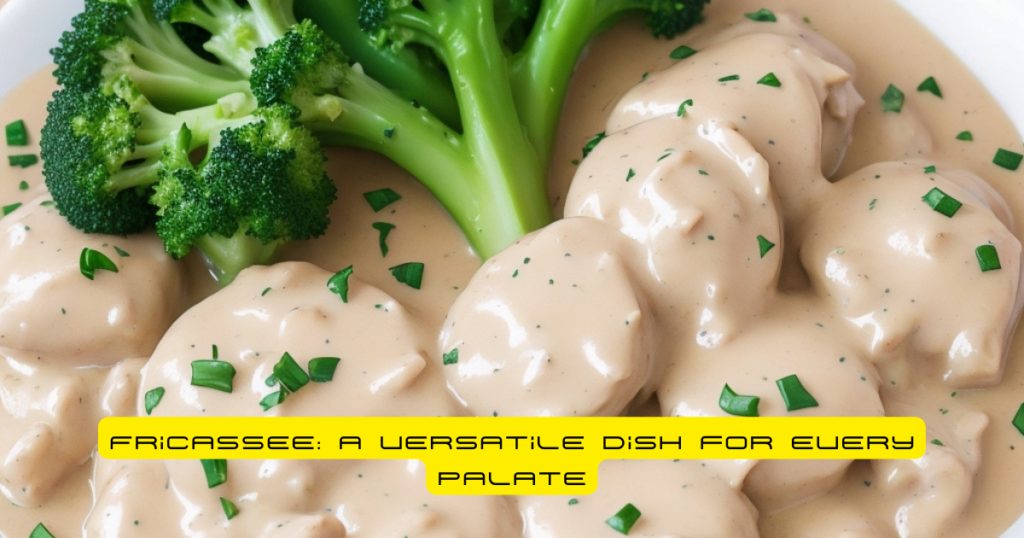Introduction
Fricassee, a culinary gem cherished by food enthusiasts around the world, is a dish that embodies the essence of comfort and flavor. Originating from the French cuisine, fricassee has evolved over centuries and found its place in kitchens from Europe to the Americas. In this blog, we will explore the fascinating history of this dish, how it is traditionally made, and provide a simple recipe for you to savor the comforting goodness of a homemade fricassee.

The Origins of Fricassee
The term “fricassee” finds its roots in the Middle French word “frire,” meaning “to fry.” While the exact origin of fricassee is debated, it gained popularity in France during the 16th century. Initially, it was a method of cooking used for various meats, especially game birds. Over time, fricassee became a versatile dish featuring a creamy sauce and tender pieces of meat, often served with vegetables.
The Art of Making Fricassee
Fricassee is renowned for its rich, creamy sauce and tender, succulent meat or poultry. Here’s a step-by-step guide on how to prepare a classic chicken fricassee:
Ingredients:
- 1 whole chicken (about 3-4 pounds), cut into pieces
- 2 tablespoons butter
- 2 tablespoons olive oil
- 1 onion, finely chopped
- 2 cloves garlic, minced
- 1 carrot, diced
- 1 celery stalk, diced
- 8 ounces mushrooms, sliced
- 2 tablespoons all-purpose flour
- 1 cup chicken broth
- 1 cup white wine
- 1 cup heavy cream
- Salt and pepper to taste
- Fresh parsley, chopped, for garnish
Instructions:
- Season the chicken pieces with salt and pepper. Heat Butter and olive oil over medium-high heat in a large skillet or Dutch oven..
- Add the chicken pieces and cook for 5 to 7 minutes, or until they are well-browned all over. Chicken should be taken out of the pan and put aside.
- Add the diced onion, garlic, carrot, celery, and mushrooms to the same pan. The vegetables should be sautéed for around 5 minutes or until they are soft.
- Sprinkle the flour over the sautéed vegetables and stir well to create a roux. Cook for another 2-3 minutes, allowing the flour to brown slightly.
- Gradually add the chicken broth, white wine, and heavy cream to the pan, stirring constantly to create a smooth sauce.
- Return the browned chicken pieces to the pan, ensuring they are submerged in the sauce. Bring the mixture to a simmer.
- Reduce the heat to low, cover the pan, and let it simmer gently for about 30-40 minutes, or until the chicken is cooked through and tender.
- Add salt and pepper to taste when preparing the fricassee. Before serving, garnish with freshly cut parsley.
The Versatility of Fricassee
While chicken fricassee is a classic preparation, the beauty of this dish lies in its versatility. Fricassee can be made with various proteins, including rabbit, veal, or seafood. Vegetarian versions can also be crafted using mushrooms or tofu as the main ingredient.
A Global Delight
Fricassee has transcended its French origins and has become a beloved dish in many countries. In the southern United States, it is a staple, often prepared with chicken or seafood and served over rice or biscuits. In Caribbean cuisine, fricassee is made with goat meat or seafood and is richly spiced with local flavors.
Fricassee and Comfort Food
What makes fricassee truly special is its status as a comfort food. The creamy sauce, tender meat, and harmonious blend of flavors make it a dish that soothes the soul. It’s a meal that warms you from the inside out on a chilly evening or offers solace when you crave the familiar tastes of home.
Conclusion
Fricassee is more than just a dish; it’s a culinary journey through history and comfort. Whether you prepare a classic chicken fricassee or explore variations with different meats and spices, you’re embracing a tradition that spans continents and cultures. So, the next time you’re in the mood for a hearty, comforting meal, consider whipping up a delicious fricassee to savor the rich flavors and warm embrace of this timeless dish.

